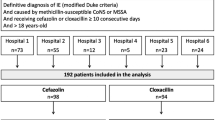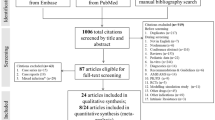Summary
Pefloxacin was applied to a newborn suffering from ventriculitis caused byKlebsiella pneumoniae after failure of routine antibiotics. Treatment was successful. Blood and CSF levels were high, thus documenting good CSF penetration. In addition to this case report, a review of the literature regarding seven neonates with CNS infection treated with fluoroquinolones and from whom CSF levels were obtained, is presented. In conclusion, due to their excellent activity against gram-negative microorganisms, fluoroquinolones may be considered in the treatment of neonatal CNS infections if the pathogen is resistant to routinely used antibiotics. Only limited experience is available with fluoroquinolones in pediatric patients given their potential for cartilage toxicity in young animals.
Zusammenfassung
Nach Versagen von Routineantibiotika wurde Pefloxacin eingesetzt, um eine durchKlebsiella pneumoniae verursachte Ventrikulitis bei einem Neugeborenen zu behandeln. Die Therapie war erfolgreich. Im Blut und im Liquor cerebrospinalis fanden sich hohe Spiegel von Pefloxacin. Die hohe Penetrationsrate von Pefloxacin in den Liquor ist damit dokumentiert. In einer Literaturübersicht werden sieben weitere Fälle von ZNS-Infektionen bei Neugeborenen dargestellt, die unter Bestimmung der Liquorspiegel mit Fluorochinolonen behandelt wurden. Fluorochinolone kommen wegen ihrer hohen Aktivität gegen gramnegative Bakterien für die Behandlung einer gegen herkömmliche Antibiotika resistenten gramnegativen ZNS-Infektion bei Neugeborenen in Frage. Die Erfahrungen mit Fluorochinolonen sind bei pädiatrischen Patienten jedoch wegen der Möglichkeit einer bei jungen Tieren beobachteten Knorpelschädigung begrenzt.
Similar content being viewed by others
References
De Louvois, J., Blackbourn, J., Hurley, R., Harvey, D. Infantile meningitis in England and Wales: a two year study. Arch. Dis. Child. 66 (1991) 603–607.
Schaad, U. B. Role of the new quinolones in pediatric practice. Pediatr. Infect. Dis. J. 11 (1992) 1043–1046.
Douidar, J. M., Snodgrass, W. R. Potential role of fluoroquinolones in pediatric infections. Rev. Infect. Dis. 6 (1989) 878–889.
McClain, J. B., Rhoads, J., Krol, G. Cerebrospinal fluid concentrations of ciprofloxacin in subjects with uninflamed meninges. J. Antimicrob. Chemother. 21 (1988) 808–809.
Wolff, M., Boutron, L., Singlas, E., Clair, B., Decazes, J. M., Regnier, B. Penetration of ciprofloxacin into cerebrospinal fluid of patients with bacterial meningitis. Antimicrob. Agents Chemother. 31 (1987) 899–902.
Isaacs, D., Slack, M. P. E., Wilkinson, A. R., Westwood, A. W. Successful treatment ofPseudomonas ventriculitis with ciprofloxacin. J. Antimicrob. Chemother 17 (1986) 535–538.
Bannon, M. J., Stutchfield, P. R., Weinling, A. M., Damjanovic, V. Ciprofloxacin in neonatalEnterobacter cloacae septicaemia. Arch. Dis. Child 64 (1989) 1388–1391.
Lumbiganon, P., Pengsaa, K., Sookpranee, T. Ciprofloxacin in neonates and its possible adverse effect on the teeth. Pediatr. Infect. Dis. J. 10 (1991) 619–620.
Wolff, M., Regnier, B., Daldoss, C., Nkam, M., Vachon, F. Penetration of pefloxacin into cerebrospinal fluid of patients with meningitis. Antimicrob. Agents Chemother. 26 (1984) 289–291.
Wessalowski, R., Thoma, L., Kivit, J., Voit, T. Multiple brain abscesses caused bySalmonella enteritidis in a neonate: successful treatment with ciprofloxacin. Pediatr. Infect Dis. J. 12 (1993) 685–688.
Green, S. D. R., Ilunga, F., Cheesbrough, J. S., Tillotson, G. S., Hichens, M., Flemingham, D. The treatment of neonatal meningitis due to gram-negative bacilli with ciprofloxacin: evidence of satisfactory penetration into cerebrospinal fluid. J. Infect. 26 (1993) 253–256.
Goepp, J. G., Carlton, K. K., Anderson, T., Dick, J. D., Stokoe, J. M., Eiden, M. Use of ciprofloxacin in an infant with ventriculitis. J. Pediatr. 121 (1992) 303–305.
Dagan, R., Schlaeffer, F., Einhorn, M. Parenteral fluoroquinolones in children with life-threatening infections. Infection 18 (1990) 237–238.
Ragunathan, P. L., Potkins, D. V., Waston, J. G., Kearns, A. M., Carroll, A. Neonatal meningitis due toSalmonella typhimurium treated with ciprofloxacin. J. Antimicrob. Chemother. 26 (1990) 727–728.
Fass, R. In vitro activity of ciprofloxacin. Antimicrob. Agents Chemother. 24 (1983) 568–574.
Modai, J. Potential role of fluoroquinolones in the treatment of bacterial meningitis. Eur. J. Clin. Microbiol. Infect Dis. 10 (1991) 291–295.
Author information
Authors and Affiliations
Rights and permissions
About this article
Cite this article
Linder, N., Kuint, J., Reichman, B. et al. Ventriculitis caused byKlebsiella pneumoniae successfully treated with pefloxacin in a neonate. Infection 22, 210–212 (1994). https://doi.org/10.1007/BF01716707
Received:
Accepted:
Issue Date:
DOI: https://doi.org/10.1007/BF01716707




